Scarnecchia -- an Original Domino Game
Invented by Howard Fosdick (V 1.0) © BestFreeNewGames.com
Overview: In this game, players "fish" for domino tiles from the "pool" of face up tiles on the table. Play is quick and easy, though not devoid of challenge.
Players and Equipment: For the basic game, two players use a set of 6-6 dominoes. After learning the basic game, some use two 6-6 sets of dominoes for a longer, more challenging game.
Objective: To win the hand (or deal) by scoring the most points.
Start: Turn all dominoes faces down and shuffle. Two players each draw four tiles for their hands.
Four more tiles are laid face up between the players. These are collectively called the pool. Remaining tiles become the draw stock and are left face down at the side of the table.
Randomly select a player for the first turn in the first hand. In subsequent hands, the loser of the previous hand goes first.
Play: In his turn, each player plays one tile from his hand to the table. After his turn, he draws one tile from the draw stock. So a player starts each turn with four tiles in hand.
Turns: In his turn, a player may do one of the following with the single tile he plays:
- Capture -- Capture one or more tiles from the pool and take them as his winnings.
- Build -- Play a tile to the table such that he can capture two or more tiles in a subsequent turn.
- Trail -- Add a tile to those in the pool. If a player cannot capture or build, he is required to trail.
Here are the specifics for each option:
1. Capture (simple): One tile from a player's hand has the same total dot count as one tile in the pool. The player displays the tile in his hand and captures the tile from the pool. He places both tiles face down in his winnings pile over at his side of the table.
All blanks on dominoes represent zeros. Thus, the 4-blank tile is treated as a 4-0 tile in Scarnechhia, and will be referred to as such in the remainder of these rules.
2. Capture (multiple): One tile from a player's hand has the same total dot count as two or more tiles on the table when they are added together. The player displays the tile in his hand and captures all the corresponding tiles from the pool. He places all the tiles face down in his winnings pile over at his side of the table. Here's an example of a multiple capture:
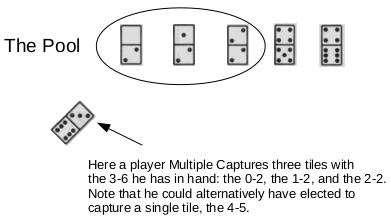
3. Build (simple): The player adds a tile from his hand to a tile on the table. This "builds" a new sum for the two conjoined tiles in the pool. The player is required to state the target sum he is building. He will be required to display a tile with that sum in his next turn and capture the two tiles composing his target sum. Here is an example:
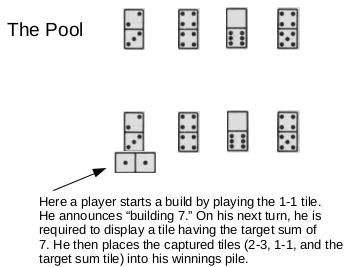
When building, a player must show the target sum tile from his hand on his next turn immediately after completing the build. Failure to do so violates the rules and loses the hand. The player places the tiles involved in the build and the tile used for their capture face down into his winnings pile.
Note it is possible the opponent could play a target sum tile in his intervening turn and steal the build away from its creator. This is called stealing a build and is a risk the builder faces.
In the above example, assume the player creating the 7-build has the 4-3 tile in hand. He lays down the 1-1 tile and announces "building 7". However, before his next turn (in which he intends to display the 4-3 to capture the 2-3 and 1-1 tiles), his opponent steals the build by presenting the 5-2 tile. Oops! The opponent steals the build and captures the tiles. The player with the 4-3 is released from his build obligation to play the 4-3 domino and is free to play whatever piece he likes in his next turn.
An opponent can also steal a build by altering its target sum. Here's an example of how this works:
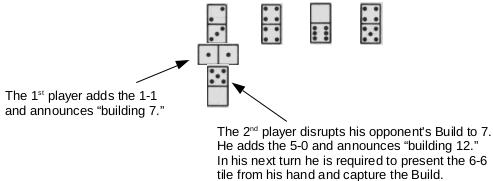
In this example, the first player adds the 1-1 to the 2-3 and announces "building 7". In his turn, the opponent adds a 5-0 tile to the 2-3 and 1-1, and says "building 12". The target sum for the build is now 12. This second player is required to have a tile with 12 total pips on it in hand and must display it in his next turn to capture the build. (Failure to do so violates the rules and loses the hand.) Of course, if possible, the first player can steal the build back from his opponent if he happens to have in hand a tile matching new target sum.
When the target sum for any build is altered by an opponent, the player who started the build is released from his obligation to play his initial target sum tile in his next turn.
No player can combine a build with multiple capture. Tiles in a build cannot be combined with other pool tiles (outside the build) when captured. Only single tiles in the pool are eligible for multiple capture.
4. Build (multiple): In a simple build, a player adds one tile to the pool in one turn, and captures the two tiles in his next turn. In a multiple build, the player adds more than one tile from his hand to one on the table in order to create a total pip count that one tile in his hand can capture. He can only add one tile to the pool each turn to create the multiple build. So the operation spans several turns.
In the example below, a player "builds 10" across two turns. In his first turn, he places the 1-1 below the 1-2 and announces "building 10". In his second turn, he adds the 0-5 tile. He has now created the build target sum of 10 he announced.
In his third turn, the player is required to display a 10-pip tile from his hand. He then takes the 1-2, 1-1, 0-5, and the target sum tile from his hand, and places them all face down in his winnings pile.
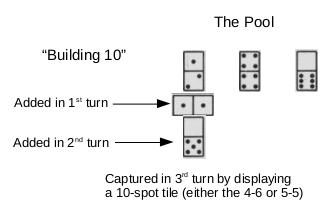
For a multiple build, the player doing the building is not required to have a tile in hand for any intermediate total pip count, only a tile that permits him to capture the build after he completes it. He always announces the final pip count he is building towards (not any intermediate pip count).
As with any build, in his turn the opponent can either:
- Capture the build by displaying a tile from his hand having the current total pip count of the build (this can be either an intermediate build sum, or the final build sum, whichever is presently on the table)
- Alter the build by adding a tile and announcing his own target total pip count
- Ignore the build and implement other plays
5. Trail: A player can trail in any turn. This means he simply takes a tile from his hand and places it face up into the pool at the end of the line of tiles. A player is free to trail any time he wishes to (except when in the middle of a build, of course). A player is required to trail a domino if he cannot capture or build. Players typically trail only if unable to capture or build.
Sweeps: When a player captures all the tiles from the pool in one play, he cleans or sweeps the table. This scores extra points. It also forces his opponent to trail in his turn, since there are no tiles left in the pool to capture or build upon.
The 0-0 Tile: If a player has the 0-0 tile in his hand (the blank-blank tile), he is required to play it to the pool first in order to win it. The player may use it as part of a build or he may trail with it. A player may not simply show the 0-0 tile from his hand and place it in his winnings pile as part of some other capture.
If a player adds the 0-0 to any build (his own or his opponent's), it does not change the total target pip count of the build. It is, however, a valid component to the build process.
Example: The 1-1 tile is in the pool. A player holds the 0-0 and 0-2 tiles in his hand. He could capture the 0-0 tile by adding it to the 1-1 tile in the pool and stating "building 2". Displaying the 0-2 bone in his next turn captures the 1-1, 0-0, and 0-2 dominoes for his winnings pile.
End of Game: Play stops after the player who draws the last tile from the drawing stock completes his turn. Dominoes still in hand or the pool at the end of the game score no points.
Scoring: There are three alternative ways to score Scarnecchia. Agree before play which system you'll use. Scoring by tiles is simplest, whilst scoring by threes is most challenging:
By Tiles: Count 1 point for each tile won,
and award 3 points for each sweep.
---or---
By Points: Players score as follows:
| Tiles: | 1 point to the player who wins the most tiles |
| Doublets: | 1 point to the player who wins the most doublets |
| 3-Spots: | 1 point to the player who
wins the most tiles showing a 3-spot |
| Sweeps: | 1 point for each sweep |
---or---
By Threes: Players score the same as By Points.
The sole difference is that tiles having a 3-spot on their face score 1 point for each 3-spot won.
The 3-3 tile counts as two 3-spots and thus scores 2 points.
Click here for a Scoring Summary Chart.
-----------------------------------
Tips for Play: This is a game of choices and memory. Lighter tiles are useful in building target sums. Heavier tiles are valuable in multiple captures and to capture builds.
For builds and multiple builds, carefully consider whether your opponent can intervene and disrupt your play. This requires knowledge of what tiles are still out, and what your opponent has hinted he may have in hand by past plays.
Note that a player could simply trail tiles from his hand that he wants to capture instead creating a build with them. In the first example above, instead of "building 7" by attaching the 1-1 to the 2-3, the player could simply trail the 1-1. Then, in his next turn he could multiple capture the 2-3 and 1-1 with his 7-spot tile:
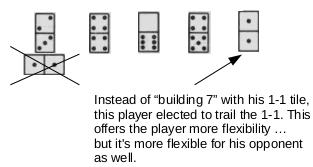
A build can be advantageous because it locks a group of tiles together into a single total pip count, rather than trailing another "loose" domino in the pool and giving the opponent greater flexibility in capture choices. However, depending on what tiles are out, simply trailing can present advantages over the more restrictive build rules. A build predetermines the builder's next play and sometimes the opponent can take advantage of that. Consider whether a build or trail works to your advantage in any specific situation.
If forced to trail, consider how likely it is your opponent will capture the tile you trail. Trail a piece you can take in the next turn. When you have a choice, trail a less valuable tile and take it on the next turn with a more valuable tile. For example, if you're scoring By Threes, place the 2-4 in the pool and capture it with the 3-3 from your hand next turn. This captures the two points for the 3-3 without exposing it to possible capture by your opponent.
A player can prevent sweeps by ensuring the total pip count on the table exceeds the pip count of any single tile not yet played. Remember, captures can only be effected by a single tile from the hand. Consider whether any capture is worth it if it means your opponent can sweep in his turn.
If you have the 0-0 in hand, an easy technique to capture it is to add it to any tile in the pool that your opponent doesn't appear able to capture, and call it a build with the same target pip total as the original tile. Then capture both tiles on the next turn with the appropriate target sum tile from the hand. Alternatively, you may wish to add the 0-0 to any multiple build you create.
Using two sets of 6-6 dominoes means there are two of each tile in the game. Steals and sweeps become more common in the two set game.
This histogram shows the 28 dominoes in a standard set and how many there are of each total pip count:
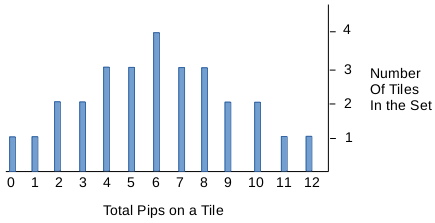
-----------------------------------
License: Feel free to print, copy, and distribute these rules, so long as you retain this paragraph. Invented by Howard Fosdick © 2023, distributed under Creative Commons License CC BY-NC-ND. HOME